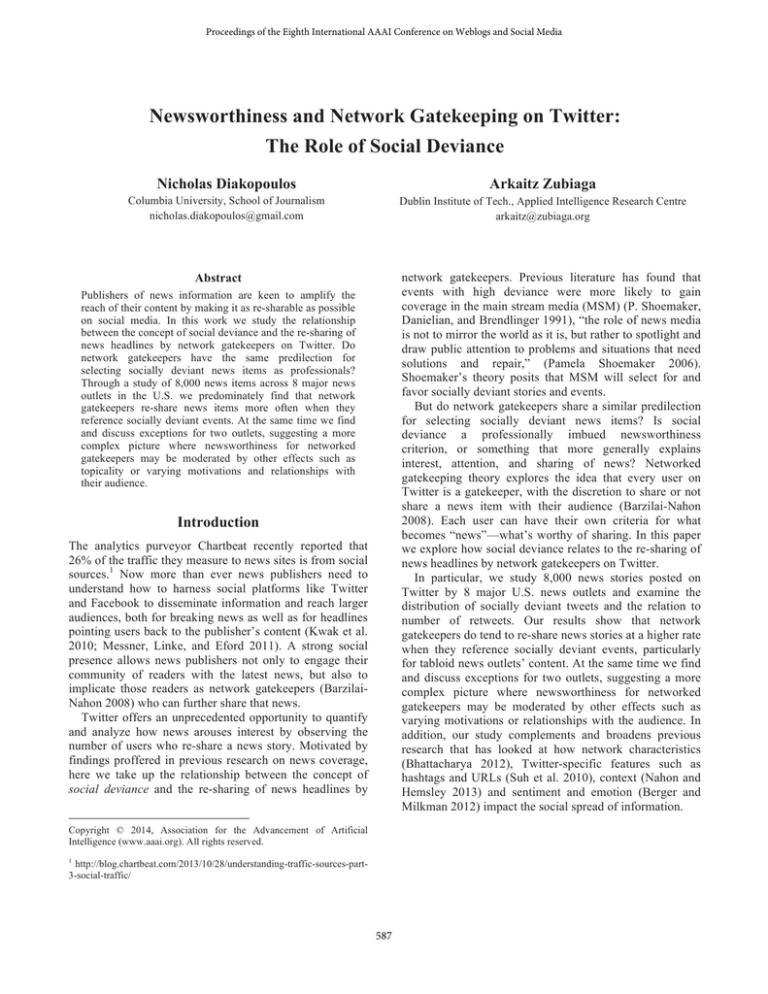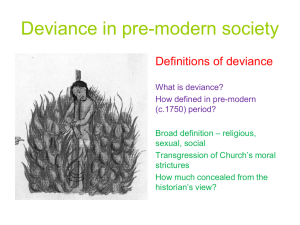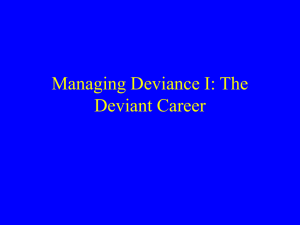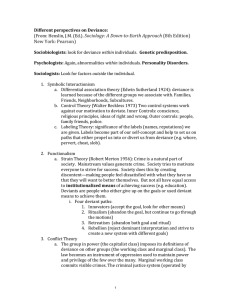
Proceedings of the Eighth International AAAI Conference on Weblogs and Social Media
Newsworthiness and Network Gatekeeping on Twitter:
The Role of Social Deviance
Nicholas Diakopoulos
Arkaitz Zubiaga
Columbia University, School of Journalism
nicholas.diakopoulos@gmail.com
Dublin Institute of Tech., Applied Intelligence Research Centre
arkaitz@zubiaga.org
network gatekeepers. Previous literature has found that
events with high deviance were more likely to gain
coverage in the main stream media (MSM) (P. Shoemaker,
Danielian, and Brendlinger 1991), “the role of news media
is not to mirror the world as it is, but rather to spotlight and
draw public attention to problems and situations that need
solutions and repair,” (Pamela Shoemaker 2006).
Shoemaker’s theory posits that MSM will select for and
favor socially deviant stories and events.
But do network gatekeepers share a similar predilection
for selecting socially deviant news items? Is social
deviance a professionally imbued newsworthiness
criterion, or something that more generally explains
interest, attention, and sharing of news? Networked
gatekeeping theory explores the idea that every user on
Twitter is a gatekeeper, with the discretion to share or not
share a news item with their audience (Barzilai-Nahon
2008). Each user can have their own criteria for what
becomes “news”—what’s worthy of sharing. In this paper
we explore how social deviance relates to the re-sharing of
news headlines by network gatekeepers on Twitter.
In particular, we study 8,000 news stories posted on
Twitter by 8 major U.S. news outlets and examine the
distribution of socially deviant tweets and the relation to
number of retweets. Our results show that network
gatekeepers do tend to re-share news stories at a higher rate
when they reference socially deviant events, particularly
for tabloid news outlets’ content. At the same time we find
and discuss exceptions for two outlets, suggesting a more
complex picture where newsworthiness for networked
gatekeepers may be moderated by other effects such as
varying motivations or relationships with the audience. In
addition, our study complements and broadens previous
research that has looked at how network characteristics
(Bhattacharya 2012), Twitter-specific features such as
hashtags and URLs (Suh et al. 2010), context (Nahon and
Hemsley 2013) and sentiment and emotion (Berger and
Milkman 2012) impact the social spread of information.
Abstract
Publishers of news information are keen to amplify the
reach of their content by making it as re-sharable as possible
on social media. In this work we study the relationship
between the concept of social deviance and the re-sharing of
news headlines by network gatekeepers on Twitter. Do
network gatekeepers have the same predilection for
selecting socially deviant news items as professionals?
Through a study of 8,000 news items across 8 major news
outlets in the U.S. we predominately find that network
gatekeepers re-share news items more often when they
reference socially deviant events. At the same time we find
and discuss exceptions for two outlets, suggesting a more
complex picture where newsworthiness for networked
gatekeepers may be moderated by other effects such as
topicality or varying motivations and relationships with
their audience.
Introduction
The analytics purveyor Chartbeat recently reported that
26% of the traffic they measure to news sites is from social
sources.1 Now more than ever news publishers need to
understand how to harness social platforms like Twitter
and Facebook to disseminate information and reach larger
audiences, both for breaking news as well as for headlines
pointing users back to the publisher’s content (Kwak et al.
2010; Messner, Linke, and Eford 2011). A strong social
presence allows news publishers not only to engage their
community of readers with the latest news, but also to
implicate those readers as network gatekeepers (BarzilaiNahon 2008) who can further share that news.
Twitter offers an unprecedented opportunity to quantify
and analyze how news arouses interest by observing the
number of users who re-share a news story. Motivated by
findings proffered in previous research on news coverage,
here we take up the relationship between the concept of
social deviance and the re-sharing of news headlines by
Copyright © 2014, Association for the Advancement of Artificial
Intelligence (www.aaai.org). All rights reserved.
1
http://blog.chartbeat.com/2013/10/28/understanding-traffic-sources-part3-social-traffic/
587
Measuring Social Deviance
Analysis of Social Deviance
With the aim of producing a subset of tweets coded for
whether they are socially deviant or not, we carried out an
iterative process to create a groundtruth and to define
sound coding guidelines for Amazon Mechanical Turk
(AMT) workers. In the first iteration, 100 tweets were
randomly selected from our dataset and each coded by the
two researchers with a binary value for social deviance.
From an initial agreement of 92% between the two
researchers, most coding disagreements were resolved
through iteration; discussion resulted in an agreement of
98% and a Fleiss' Kappa inter-coder agreement of 0.96.
Through this initial process we were able to articulate a
more precise definition of social deviance to be provided to
the AMT workers:
In this section we describe our data collection process,
define and operationalize social deviance, and present
results for how social deviance varies across outlets and
plays a role in re-sharing of headlines.
Data Collection
We identified the top 25 U.S. daily newspapers by
circulation from the 2012 AAM circulation report.2 To
ensure sufficient variance in the number of retweets for
each outlet we focused on the eight newspapers with more
than 100k Twitter followers: the Wall Street Journal
(@WSJ), USA Today (@USAToday), New York Times
(@nytimes), Los Angeles Times (@latimes), NY Daily
News (@nydailynews), New York Post (@nypost),
Washington Post (@washingtonpost), and Chicago
Tribune (@chicagotribune).
For each outlet’s account we collected all tweets from
Nov. 1st, 2011 to Oct. 31st, 2012. Across the eight outlets
this resulted in 119,498 tweets, of which 107,066 had news
headlines with content links to the site of the form: <story
headline> + <link>. Since this is the most prevalent pattern
of use of Twitter by news organizations (Messner et al.
2011) we focus our analysis on these tweets. We used the
Topsy API to collect historical tweets due to Twitter API
limitations.3 However, retweet information was collected
directly from the Twitter site.
“Does the headline refer to an event or topic that
is socially deviant, such as a violation of social
norms or challenge to the status quo, as
understood from a contemporary U.S. cultural
point of view?”
Each of the 100 tweets was coded by five workers, with
the restriction that workers had to be from the U.S. Using
majority voting, we labeled the tweets deemed deviant by
workers and compared them to the researchers’ groundtruth. This led to an agreement rate of 96% and a Fleiss'
Kappa of 0.93 with respect to the ground-truth, indicating
that the workers were largely able to understand and apply
the definition of social deviance that we supplied.
We then selected a larger subset of tweets to be coded
according to deviance. We sampled 1,000 tweets from each
of the eight news outlets under study. These were selected
such that 200 came from each of five quintiles as defined
by number of retweets. This provided a variety of tweets
across a range of levels of retweeting and allowed us to see
differences in deviance patterns across quintiles. The final
set of tweets was coded by AMT workers according to the
guidelines above: each tweet was coded by five workers
and the final decision was made using majority voting. For
example, “Principal busted for spying on students through
Facebook quits” was rated as a deviant tweet in our corpus,
whereas “Oil jumps to 9-month high after Iran cuts supply”
was rated as non-deviant.
Defining Social Deviance
Different societies, cultures, and sub-cultures often have
their own social norms of what constitutes acceptable
behavior within that group. More formally, a social norm
can be defined as a “stable, shared conception of the
behavior appropriate or inappropriate to a given social
context, that dictates expectancies of others' behavior, and
provides 'rules' for one's own behavior” (McKirnan 1980).
When a person violates a social norm, it is considered to be
a socially deviant action. Social norms often but not always
overlap with legal norms of behavior: for instance, murder
is a violation of both a legal code and a social norm, but
plagiarism, while not illegal, is a violation of a social
norm. In this work we consider a news event to be socially
deviant when it violates a social or legal norm. (P.
Shoemaker et al. 1991).
Here we study the re-sharing behavior of network
gatekeepers on Twitter depending on whether the news
headline references a socially deviant event. Examples of
news stories involving social deviance include robbery,
homicide, or violence, while examples with no social
deviance include a sports game, a political event,
someone's passing, or a natural disaster where no human is
violating any norm.
2
3
Results
The coding process resulted in a balance of 1,512 deviant
(18.9%) and 6,488 non-deviant (81.1%) tweets. Three
outlets stand out with deviance rates above 25%: NY Daily
News (30.6%), New York Post (27.4%) and Chicago
Tribune (26.5%). The least deviant outlet was the Wall
Street Journal (7.7%). The other outlets had moderate
amounts of deviance: New York Times (12.9%),
Washington Post (14.0%), USA Today (14.8%), and LA
Times (17.3%). Outlets tweeted 121 links that were
repeated across tweets with different headlines e.g. to a
homepage, news app, or evolving blog, however there was
http://www.auditedmedia.com/
http://code.google.com/p/otterapi/
588
Figure 1. Percentage of deviant tweets across quintiles
defined by number of retweets (Q5 is top, Q1 is bottom)
no difference in the rate of deviant vs. non-deviant events
in those tweets with repeated links. In line with related
work (P. Shoemaker et al. 1991), these results underscore
deviance as a salient newsworthiness criterion for many of
these outlets, though with considerable variance between
them.
Figure 1 shows the distribution of deviant tweet rates
across quintiles defined by the number of retweets and
aggregated for all outlets. The two top quintiles (Q4, Q5)
have the highest rate of deviant tweets and the rate
decreases in lower quintiles, the bottom quintile being the
2
lowest (𝝌 = 35.298, DOF = 4, p < 0.0001). This supports
the idea that deviant news items do evoke additional
attention and re-sharing from network gatekeepers: among
the tweets that are more often retweeted (i.e. Q5) deviant
topics are more prevalent and comprise a larger portion of
the news.
We also looked at the distribution of deviance for each
outlet to understand any variation in network gatekeeping
behavior across outlets. With the exceptions of the WSJ
and Chicago Tribune (which we discuss further below), the
other six outlets had substantial differences between their
bottom and top quintiles in terms of proportion of deviant
tweets (See Figure 2). Papers known to have reputations as
more balanced and objective sources (i.e. NY Times, LA
Times, and Washington Post) tend to have smaller
disparities among bottom and top quintiles, whereas papers
with tabloid reputations (i.e. NY Post and NY Daily News)
4
have much larger disparities (e.g. NY Post, at 24%, was
largest). So not only do the tabloids have higher rates of
socially deviant headlines (30.6% and 27.4%), but those
headlines also comprise a larger fraction of the top
retweeted tweets, suggesting that the audiences for those
outlets may be particularly interested in re-sharing socially
deviant news; for those network gatekeepers social
deviance is an especially salient newsworthiness criterion.
To provide stronger statistical evidence of the
relationship between deviance and retweets, both overall
and for each outlet, we perform Mann-Whitney-Wilcoxon
(MWW) tests. We normalize retweet counts by computing
z-scores from the averages and standard deviations for
each outlet, which allows us to compare outlets as well as
4
Figure 2. Percentage of deviant tweets across outlets and
between top and bottom quintiles.
compute an aggregate statistical test across all outlets.
Table 1 shows the Z statistic and significance values of
each test. When we consider all outlets together we find a
statistically significant difference, with deviant tweets
garnering more retweets (mean z-score = 0.29) than nondeviant tweets (mean z-score = 0.13). When we look at
each individual outlet we find that for six of the outlets
deviant news tends to be retweeted significantly more. The
exceptions include the Wall Street Journal (WSJ), which is
significant in the opposite direction, and Chicago Tribune
(CT), whose difference is not statistically significant.
To better understand the two outlets where network
gatekeepers did not seem to find social deviance as
important a newsworthiness criterion, we carefully read
through all of the deviant headlines for those outlets. The
deviant stories covered by WSJ included few breaking
news items, opting more for investigative pieces about
criminal issues or for international stories. Moreover, the
WSJ has a specific focus on business, market, and
economic news, the audience for which may be less
interested in reading about and sharing socially deviant
news, especially in comparison to some of the tabloid
outlets we examined. At the CT the majority of top reshared deviant stories included many shootings and crimereports, with headlines often explicitly including numbers
Table 1. Wilcoxon Rank Sum tests showing statistical
differences in # of retweets for deviant vs. non-deviant news.
News outlet
Wall Street Journal
USA Today
New York Times
LA Times
NY Daily News
NY Post
Washington Post
Chicago Tribune
Overall
http://en.wikipedia.org/wiki/New_York_Post
589
Z
2.120
-3.584
-3.020
-3.086
-3.777
-6.097
-4.144
1.531
-7.535
p
0.034
3.385x10-4
2.524x10-4
2.030x10-3
1.586x10-4
1.077x10-9
3.410x10-5
.126
4.887x10-14
reference to the power elite, reference to celebrities,
entertainment, surprise, bad news, good news, magnitude
(i.e. significance to a large number of people), cultural
relevance to audience, follow-up, and newspaper agenda.
In the same way that there are other dimensions of
professional newsworthiness decisions besides deviance,
there are other factors that also help explain what makes
something newsworthy for a network gatekeeper. For
instance, self-presentation effects and concern for your
audience (boyd, Golder, and Lotan 2010), as well as
motivations to share content such as humor which are
unrelated to the newsiness of the event (André, Bernstein,
and Luther 2012) could modulate whether a network
gatekeeper chooses to re-share a headline.
Future work will strive to better understand the entire
matrix of newsworthiness effects and the nuance of how
and why network gatekeepers respond and may respond
differently than professionals. While our study has focused
on U.S. news outlets that release daily print copies, future
work might also examine outlets from other countries, and
other kinds of news media, such as digital native sites,
news wires, or broadcast news outlets.
of dead or wounded. At the same time, many of the least
re-shared deviant stories also included crime, but of lower
salience, such as local robberies or abuses.
To help further explain the disparity in results for WSJ
and CT, we computed the average z-score value for all
words used in any deviant tweet. This allowed us to rank
words used in deviant tweets by the extent to which they
are re-shared and to see where there was a divergence
between the topics that MSM was publishing and the
topics that the network gatekeepers were most interested in
re-sharing. We carefully read through that list looking both
at the words in deviant tweets that were least, as well as
most, retweeted. In the least retweeted list we found many
words relating to court processes such as “accuser,”
“lawyer,” “guilty,” “sues,” “charge,” “allegation,”
“sentence,” and “jury” as well as some related to fatality
such as “suicide,” “death,” and “slaying.” In the mostretweeted list were words relating to crime such as
“police,” “cops,” “arrest,” “killed,” “shooting,” “attack,” as
well as titillations such as “porn” and “sex”. We computed
the fraction of deviant tweets that used any of the 25
different least retweeted words related to court activity or
fatality and found that both WSJ and CT used those words
2
at a higher rate than the other outlets (𝝌 = 98.79, DOF = 1,
p < 0.0001). By emphasizing these topics in their coverage,
WSJ and CT may not be getting as much re-sharing
activity on their deviant news headlines.
References
André, P., Bernstein, M., & Luther, K. (2012). Who Gives A Tweet?
Evaluating Microblog Content Value. In Proc. CSCW.
Barzilai-Nahon, K. (2008). Towards a theory of network gatekeeping: A
framework for exploring information control. JASIST, 59(9), 1493–1512.
Discussion and Conclusions
Berger, J., & Milkman, K. (2012). What makes online content viral?
Journal of Marketing Research, 49(2), 192–205.
In this work we have studied the connection between social
deviance and news headline re-sharing on Twitter. Our
study contributes evidence that there is indeed a
statistically significant inclination of network gatekeepers
toward re-sharing news involving socially deviant events,
just as for their professional counterparts. Our results
indicate a solid overall relationship between social
deviance and what network gatekeepers select for resharing: social deviance is generally correlated to more
retweeting. Outlets particularly known for tabloid
journalism exhibited an exaggerated effect, but results for
WSJ and CT indicate other moderating factors at play.
Upon deeper investigation we found that for the WSJ
and CT there was a focus on topics that, although deviant,
were not highly re-shareable on Twitter. These results
reinforce previous research, which has shown that
professionals are more interested in public affairs topics,
such as international stories or court proceedings, than
audiences (Boczkowski and Mitchelstein 2013). By
emphasizing these topics in their deviant tweets, it appears
to have dampened the impact of deviance on re-sharing
and helps explain the lack of statistical significance we
found for those outlets.
In a broad analysis and synthesis of modern professional
newsworthiness values, Harcup and O'Neill (Harcup and
O’Neill 2001) identify the following list of ten factors:
Bhattacharya, D. (2012). Sharing News Articles Using 140 Characters: A
Diffusion Analysis on Twitter. In Proc. ASONAM (pp. 966–971).
Boczkowski, P., & Mitchelstein, E. (2013). The news gap When the
information preferences of the media and the public diverge. MIT Press.
boyd, danah, Golder, S., & Lotan, G. (2010). Tweet, Tweet, Retweet:
Conversational Aspects of Retweeting on Twitter. In Proc. HICSS-43.
Harcup, T., & O’Neill, D. (2001). What is News? Galtung and Ruge
Revisited. Journalism Studies, 2(2), 261–280.
Kwak, H., Lee, C., Park, H., & Moon, S. (2010). What is Twitter, a social
network or a news media? In Proc. WWW.
McKirnan, D. (1980). The identification of deviance: A conceptualization
and initial test of a model of social norms. European Journal of Social
Psychology, 10(1), 75–93.
Messner, M., Linke, M., & Eford, A. (2011). Shoveling tweets: An
analysis of the microblogging engagement of traditional news
organizatinos. In Proc. ISOJ.
Nahon, K., & Hemsley, J. (2013). Going Viral. Polity Press.
Shoemaker, P. (2006). News and newsworthiness: A commentary.
Communications, 31(1), 105–111.
Shoemaker, P., Danielian, L., & Brendlinger, N. (1991). Deviant acts,
risky business and US interests: The newsworthiness of world events.
Journalism & Mass Communication Quarterly, 68(4), 781–795.
Suh, B., Hong, L., Pirolli, P., & Chi, E. (2010). Want to be retweeted?
Large scale analytics on factors impacting retweet in Twitter network. In
Proc. of SocialCom (pp. 177–184).
590







